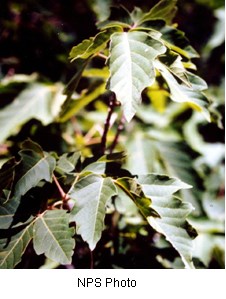
Acer negundo Family: Aceraceae – Maple Family Acer negundo is the only species from this family represented at Arches National Park; perennial tree 13.2' to 39.6' (4 to 12 meters) tall Leaves: opposite; compound; pinnate with 3 to 7 leaflets (or rarely twice compound); toothed or lobed; can have hairs; leaflets 0.8” to 4” (2 to 10 cm) long; 0.48” to 1” (12 to 25 mm) wide Flowers: no petals; 4 or 5 very small greenish yellow sepals; female (pistillate) and male (staminate) flowers, flowers appear before/with leaves; Family - stamens 3-12; flowers are dioecious (individual flowers are either male or female, but only one sex is to be found on any one plant); flowers on drooping stalks; sepals 0.04” to 0.08” (1 to 2 mm) long Pollinators: bees Fruits: 2 united samaras Blooms in Arches National Park: April, May Habitat in Arches National Park: riparian communities Location seen: outside Arches National Park in Grandstaff Canyon Other: The genus name, “Acer”, is Latin for maple and the species name, “negundo”, is from a Sanskrit name for a tree with leaves like boxelder. Its common name comes from the ability to "box" or tap for low quality syrup and for the resemblance of its leaves to Elderberry; or for the resemblance of leaves to those of elder, “Sambucus”, and to the use of the soft wood for box making. Boxelder's abundant sap contains a large proportion of sugar and can be made into a pleasant beverage. The sap was used by Native Americans and early settlers as a source of maple sugar. USE CAUTION: Boxelder can be confused with Poison ivy because the lobing of the leaves look very similar and they are both compound. Poison ivy has 3 leaflets and Boxelder can have 3 to 7 leaflets (or rarely twice compound). One way to distinguish the two is to look at the branching pattern. Poison ivy has alternate branching and Boxelder has opposite branching. This tree typically lives for 75 years, with 100 years maximum longevity. |
Last updated: April 29, 2025
